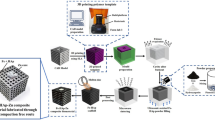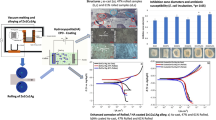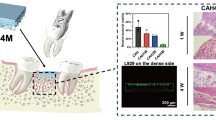Abstract
Two different hydrophilic systems were investigated regarding their suitability to be used as enzymatically degradable and highly bioactive bone cements. They contained either acrylic acid (AA) or 2-hydroxyethyl methacrylate (HEMA) as the hydrophilic monomer. Swelling, degradation, mechanical and bioactivity tests were employed to characterise their behaviour. Although both of the systems were very hydrophilic, only the one containing HEMA was able to form an apatite-like layer on its surface. Moreover, this system could be degraded by amylolytic enzymes at a rate easily controlled by the incorporation of different amounts of enzyme to the formulation, as shown by the evolution of the mechanical properties, weight loss and glucose concentration in the solution. These results show these novel systems have a great potential to induce bone ingrowth inside the pores created during the degradation of the material, therefore establishing a strong interface with the tissue.
Similar content being viewed by others
References
E. P. Lautenschlager, S. I. Stupp and J. C. Keller, in “Functional Behaviour of Orthopaedic Biomaterials Vol II: Applications”, edited by P. Ducheyne and G. W. Hastings (CRC Press, Boca Raton, 1984) pp. 87-119.
S. Shinzato, T. Nakamura, T. Kokubo and Y. Kitamura, J. Biomed. Mater. Res. 59 (2002) 225.
E. J. Harper, M. Braden and W. J. Bonfield, J. Mater. Sci.: Mater. Med. 11 (2000) 491.
L. F. Boesel, J. F. Mano and R. L. Reis, ibid. (2003). Accepted for publication.
C. S. Pereira, A. M. Cunha, R. L. Reis, B. Vázquez and J. San Román, ibid. 9 (1998) 825.
I. Espigares, C. Elvira, J. F. Mano, B. Vázquez, J. San Roman and R. L. Reis, Biomaterials 23 (2002) 1883.
M. E. Gomes, A. S. Ribeiro, P. B. Malafaya, R. L. Reis and A. M. Cunha, ibid. 22 (2001) 883.
R. L. Reis, A. M. Cunha and M. J. Bevis, Med. Plast. Biomater. 4 (1997) 46.
P. B. Malafaya, C. Elvira, A. Gallardo, J. San Román and R. L. Reis, J. Biomater. Sci. Polym. Ed. 12 (2001) 1227.
C. Elvira, B. Levenfeld, B. Vázquez and J. San Román, J Polym. Sci. A: Polym. Chem. 34 (1996) 2783.
T. K. Ghose, Pure Appl. Chem. 59 (1987) 257.
L. F. Boesel, M. H. V. Fernandes and R. L. Reis, J. Biomed. Mater. Res. B: Appl. Biomater. (2004) (in press).
Author information
Authors and Affiliations
Rights and permissions
About this article
Cite this article
Boesel, L.F., Reis, R.L. Hydrophilic matrices to be used as bioactive and degradable bone cements. Journal of Materials Science: Materials in Medicine 15, 503–506 (2004). https://doi.org/10.1023/B:JMSM.0000021128.66450.07
Issue Date:
DOI: https://doi.org/10.1023/B:JMSM.0000021128.66450.07




